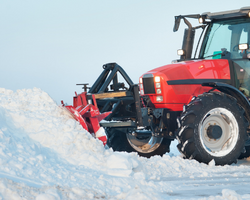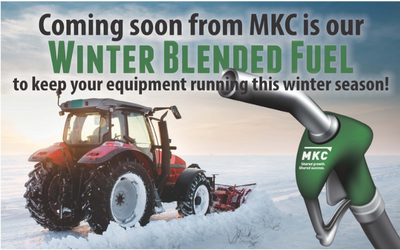|
It may seem odd for us to be talking about winter fuels and winter tank maintenance at this time of year but  discussing it now and taking action is the key to limiting issues this winter. MKC Energy understands that you have thousands of things to worry about and tend to, so we work hard to take some of those issues off your schedule. One of the ways we do that is by starting our cold flow improver winter treatments in both our delivered fuels and cardtrol locations as early as October 15. By starting the treatments at this time, it allows the opportunity to get treated fuels into bulk tanks and vehicles so when the cold does arrive, our producers and customers are already prepared. discussing it now and taking action is the key to limiting issues this winter. MKC Energy understands that you have thousands of things to worry about and tend to, so we work hard to take some of those issues off your schedule. One of the ways we do that is by starting our cold flow improver winter treatments in both our delivered fuels and cardtrol locations as early as October 15. By starting the treatments at this time, it allows the opportunity to get treated fuels into bulk tanks and vehicles so when the cold does arrive, our producers and customers are already prepared.
Another step MKC Energy takes is that we begin blending #1 diesel at our cardtrols and for the customers that request blends on November 15. Again, this allows for a window of time for the blended/treated fuels to get into bulk tanks and vehicles before the extreme temperatures arrive.
These proactive changes along with the draining and changing of fuel filters before it gets cold are three of the most important things that can be done to ensure trouble free winter months as far as fuels are concerned.
Below are some industry terms related to winter fuels.
- Cloud Point (CP) – The point at which wax crystals begin to appear.
- Cold Filter Plugging Point (CFPP) - CFPP is a cold flow operability test that chills fuel to the point it will plug a 45-micron filter. Do not be misled here, every year we see claims of additives that state this number extremely low. Most micron levels on farm diesel sets are 10-30 microns and many equipment manufacturers have filters with microns as low as 1-5. This is not a great test/standard to use for winter preparations.
- Cold Flow Improvers (CFI) - CFI is designed to extend operability of fuel by changing the diesel fuel wax structure by using wax dispersants (dispersing wax is keeping wax crystals from congregating in the fuel).
- De-Icers - Dramatically lower the point at which any water in the fuel system freezes.
- Gelling - A thickening of the fuel (similar to solidifying gelatin) caused by wax crystals which form as the fuel cools down. Gelled fuel is difficult to pump and can plug filters, preventing fuel from reaching the engine (fuel starvation). Often mistaken for ice in the fuel but can be identified as the fuel filter is warmed.
- Icing - The formation of ice crystals in a fuel containing free water when cooled to 32 degrees F or below. Although ice crystals will plug filters in the same manner as wax, it is crucial to determine which problem is occurring to take proper corrective action.
- Operability – The lowest temperature at which equipment will operate without loss of power due to a wax formation in the fuel delivery system.
- Wax Anti-Settling Agent (WASA) - WASA reduces settling of wax crystals in vehicle tanks and above ground storage tanks, which clog filters and other fuel system components.
What is the cloud point of fuel when it comes to proper blending?
It is essential to understand the cloud point of fuel when it comes to proper blending. When the temperature of the #2 distillate (not air temp) is at or below its cloud point, it will not correctly blend with #1 distillate or fuel additives. Fuel should always be blended, and additives should be added when fuel is at least 10 degrees above its cloud point. Many reported filter plugging problems can be attributed to fuels that were not correctly blended down. They may have initially been blended down properly but compromised later when straight #2 distillate was added to the tank. Cenex branded fuels are blended and injected at the rack in accordance with these guidelines. Remember, blending #1 distillate is the only way to reduce the cloud point of fuel due to the fact it typically has a considerably lower cloud point and CFPP.
An important rule of thumb is for every 10% of #1 used, the fuel cloud point will drop by 3 degrees. For example, the cloud point of #2 distillate is 10°F. Blending 50% #1 into the #2 will reduce the cloud point of the blended fuel by 15 degrees lowering the cloud point to -5°F. However, it is important to note that this rate is not continuously linear.
What are the recommended treat rates?
If there is ever a time when a tank or piece of equipment has not been able to be filled with winter treated and or blended fuels, using an off the shelf additive may be needed. If so, please follow these guidelines to ensure the best possible outcome. filled with winter treated and or blended fuels, using an off the shelf additive may be needed. If so, please follow these guidelines to ensure the best possible outcome.
-
Follow the recommended treat rate of the additive manufacture.
-
Blend fuel and fuel additives at least 10°F above the fuel’s cloud point
-
Keep in mind doubling the treat rate typically will not have a negative impact, however, it may not improve operability and adds unneeded expense. Tripling (3x or higher) the treat rate is unlikely to improve performance, but you risk the possibility of negatively impacting the operability of the blend.
To learn more about winter fuels, treating fuels and blending fuels, please contact your MKC energy consultant or the MKC Energy Department at 620-241-1885.
|
 discussing it now and taking action is the key to limiting issues this winter. MKC Energy understands that you have thousands of things to worry about and tend to, so we work hard to take some of those issues off your schedule. One of the ways we do that is by starting our cold flow improver winter treatments in both our delivered fuels and cardtrol locations as early as October 15. By starting the treatments at this time, it allows the opportunity to get treated fuels into bulk tanks and vehicles so when the cold does arrive, our producers and customers are already prepared.
discussing it now and taking action is the key to limiting issues this winter. MKC Energy understands that you have thousands of things to worry about and tend to, so we work hard to take some of those issues off your schedule. One of the ways we do that is by starting our cold flow improver winter treatments in both our delivered fuels and cardtrol locations as early as October 15. By starting the treatments at this time, it allows the opportunity to get treated fuels into bulk tanks and vehicles so when the cold does arrive, our producers and customers are already prepared. filled with winter treated and or blended fuels, using an off the shelf additive may be needed. If so, please follow these guidelines to ensure the best possible outcome.
filled with winter treated and or blended fuels, using an off the shelf additive may be needed. If so, please follow these guidelines to ensure the best possible outcome.